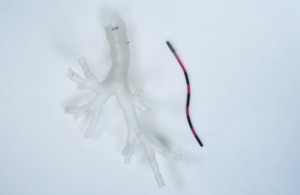
Image courtesy of the University of Leeds
Engineers at the University of Leeds have developed a magnetic tentacle robot to pass through the narrow tubes of the lungs.
Scientists and engineers at the university made a proof of concept for a robotic device that can reach the smallest bronchial tubes to take tissue samples and deliver cancer therapy.
The tentacle robot has a diameter of 2 mm, about twice the size of a ballpoint pen’s tip. Magnets outside a patient’s body guide the tentacle robot into place.
The proof of concept was based on laboratory tests with a 3D replica of a bronchial tree modeled from anatomical data. The researchers plan to further investigate the effectiveness of the device in navigating lungs from a cadaver.
Scientists and clinicians in the Storm Lab at the university said the device could change the use of robotic systems in assisting endoscopy and catheter procedures where a fine tube needs to be inserted into the body.
In gold-standard procedures, doctors insert a flexible tube-like bronchoscope through the nose or mouth and into the bronchial passages to examine the lungs and air passages. The bronchoscopes, about 3.5 to 4 mm in diameter, are limited in movement because they can only travel as far as the upper levels of the bronchial tree. Catheters or fine tubes measuring 2 mm in diameter are placed through the bronchoscope and into the smaller tubes of the lungs to reach further.
Researchers said the magnetic tentacle robot was developed to be more maneuverable using a robotic guidance system that is personalized for each procedure.
“A magnetic tentacle robot or catheter that measures 2 mm and whose shape can be magnetically controlled to conform to the bronchial tree anatomy can reach most areas of the lung, and would be an important clinical tool in the investigation and treatment of possible lung cancer and other lung diseases,” Pietro Valdastri, director of the Storm Lab who supervised the research, said in a news release. “Our system uses an autonomous magnetic guidance system which does away for the need for patients to be X-rayed while the procedure is carried out.”
The researchers had a number of challenges to overcome while developing the robotic system. Their device needed to be small and flexible enough to navigate the twists and turns of the anatomy in the bronchial tree. It also needed to autonomously guide the magnetic tentacle robot into place instead of a doctor manually maneuvering an instrument.
The small, flexible robot is manufactured from a series of interlinked cylindrical segments. Each segment is around 80 mm long and made of a soft elastomeric or rubber-like material that had tiny magnetic particles. The resulting device is a magnetic tentacle robot that is flexible enough to shapeshift and small enough to avoid catching on anatomical structures in the lungs.
Magnetic particles allow the robotic device to move “somewhat independently” under the effect of an external magnetic field, according to the researchers. Magnets mounted on a robotic arm outside of the patient’s body can be used to guide the device into the lungs for more personalized procedures.
The route for the robot is planned from pre-operative scans of the patient lungs and programmed into the robot. When the magnets outside of the body move, it develops forces on the magnetic particles in segments of the catheter, causing the particles to change shape or direction to enable the robot to move through the lungs, the researchers said.
The researchers said it could be several years before the magnet tentacle robot is available in a hospital setting.
The Storm Lab is part of the Leeds Centre for Cancer Research launched earlier this year. The research was published in the journal Soft Robotics.

